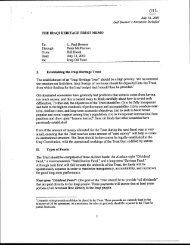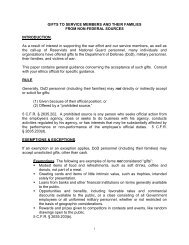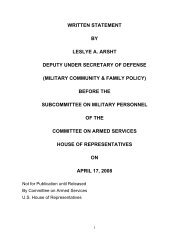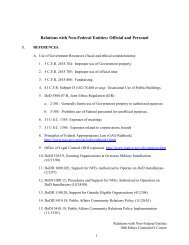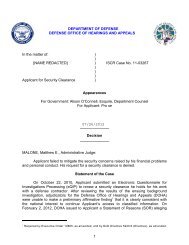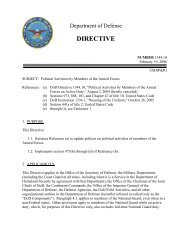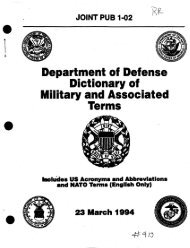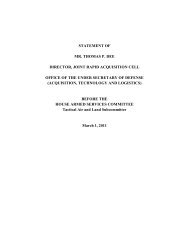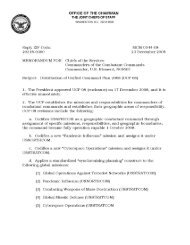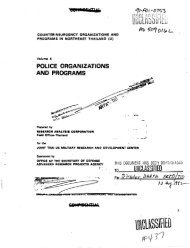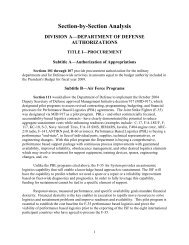dod tactical herbicide sites - United States Department of Defense
dod tactical herbicide sites - United States Department of Defense
dod tactical herbicide sites - United States Department of Defense
Create successful ePaper yourself
Turn your PDF publications into a flip-book with our unique Google optimized e-Paper software.
would require about 1,000 steel cylinders, each 10 feet long and 30 inches in diameter,642 tons <strong>of</strong> activated charcoal. In a series <strong>of</strong> tests, ACI processed 354 gallons (6.5 drums)<strong>of</strong> Herbicide Orange (taken from the NCBC Inventory). On 7 July 1976 ACI submittedits report to EPA, the <strong>Defense</strong> Supply Agency, Under Secretary <strong>of</strong> <strong>Defense</strong> forInstallations and Environment, Air Force Logistics Command, and to the Occupationaland Environmental Health Laboratory. ACI’s process was judged successful, and the<strong>Defense</strong> Supply Agency began negotiating a contract. Complications subsequentlyemerged related to disposal <strong>of</strong> the TCDD-loaded steel cartridges, and with concerns bythe Navy over the construction <strong>of</strong> a major facility at NCBC, and from EnvironmentalGroups over the reprocessing <strong>of</strong> the 2,4,5-T <strong>herbicide</strong>. In March 1977, the <strong>Department</strong> <strong>of</strong><strong>Defense</strong> recommended that all reprocessing efforts be discontinued in favor <strong>of</strong>incineration at sea. Since the incinerator ship MT Vulcanus was expected to be availablein April 1977, DoD requested EPA immediately grant the permit for the at-seaincineration <strong>of</strong> the entire Herbicide Inventories at NCBC and Johnston Island.Active duty Air Force personnel with the Occupational and Environmental HealthLaboratory, Brooks Air Force Base, Texas were intimately involved in all phases <strong>of</strong> thepilot plant construction, the handling <strong>of</strong> the Herbicide Orange, the on-site environmentalmonitoring, the oversight <strong>of</strong> the pilot plant operations, and the health and environmentalsafety programs. In addition, active duty Navy personnel with the Naval ConstructionBattalion Center provided additional oversight <strong>of</strong> the activities occurring on the Navalinstallation.Sources: <strong>Department</strong> <strong>of</strong> the Air Force (1974): Final Environmental Statement on theDisposition <strong>of</strong> Orange Herbicide by Incineration. November 1974, <strong>Department</strong> <strong>of</strong> the AirForce, Washington, DC. Unclassified, available for public distribution.Air Force Logistics Command (1976): Historical Records – Project on the Disposition <strong>of</strong>Herbicide Orange. Office <strong>of</strong> History, Air Force Logistics Command Archives, Wright-Patterson Air Force Base, Ohio.Hightower D (1976): Report <strong>of</strong> Plant Operation and Proposed Reprocessing <strong>of</strong> HerbicideOrange, 24 May—8 July 1976. Agent Chemical Company, Houstong, Texas.Miller RA, Shafts PA, Stieritz SF, Termena BJ (1980): The Disposal <strong>of</strong> HerbicideOrange, 1971-1979. Office <strong>of</strong> History, Air Force Logistics Command, Wright-PattersonAir Force Base, Ohio.70



